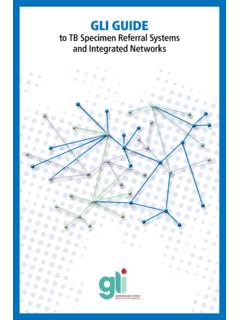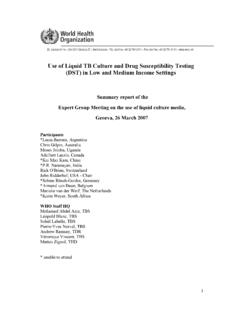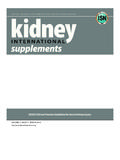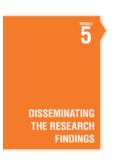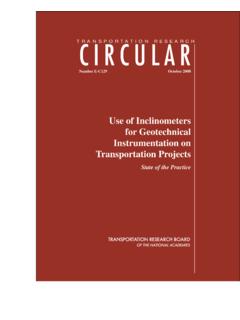Transcription of The Handbook - Laboratory Diagnosis of …
1 Laboratory Diagnosis of tuberculosis by Sputum MicroscopyThe handbookGlobal editionA publication of the Global Laboratory Initiative a Working group of the StopTB Partnershipglobal Laboratory initiative advancing TB diagnosisPublished bySA PathologyFrome Road Adelaide South Australia rights reserved. No part of this book may be reproduced or transmitted in any form or by any means without the written permission of the publisher. The authors assert their moral rights in the : 978-1-74243-602-9 ProductionProject Editor Mark Fitz-GeraldTechnical Editors Pawan Angra (CDC), Valentina Anisimova (KNCV),Christopher Gilpin (WHO), Richard Lumb (SA Pathology), Hiroko Matsumoto (JATA), Armand Van Deun (The Union) Manuscript Editors Mark Fitz-Gerald, Richard LumbIllustrations Kerry ReidDesign Sue Dyer DesignContact 2013 SA Pathology (formerly IMVS)
2 Richard LumbArmand Van DeunIvan BastianMark Fitz-GeraldLaboratory Diagnosis of tuberculosis by Sputum MicroscopyThe handbookGlobal editionLaboratory Diagnosis of tuberculosis by Sputum MicroscopyAcknowledgementsThe writing team wish to thank the World Health Organization (WHO) and the International Union Against tuberculosis and Lung Disease (The Union) for recognizing that smear microscopy remains an important tool for the Laboratory Diagnosis of tuberculosis and in monitoring patients response to Global Health Bureau, Office of Health, Infectious Disease and Nutrition (HIDN), US Agency for International Development, financially supports the development of The Handbook : Laboratory Diagnosis of tuberculosis by sputum microscopy through TB CARE I under the terms of Agreement No.
3 AID-OAA-A-10-00020. This publication was made possible by the generous support of the American people through the United States Agency for International Development (USAID). The contents are the responsibility of TB CARE I and do not necessarily reflect the views of USAID or the United States Pathology (formerly IMVS Pathology) is thanked for enabling the Tanzanian edition of The Handbook to be used as the template for the Global Laboratory Initiative (GLI) edition of The Handbook . GLI is a working group of the Stop TB go also to illustrator Kerry Reid and Sue Dyer Design for their long-standing contributions to earlier editions of The Handbook , and their enthusiastic and very professional inputs.
4 As we remarked in the first edition of The Handbook , it remains our sincere hope that the intended users of The Handbook , the technicians at the forefront of the international effort to contain and overcome TB, will find it useful in their daily Laboratory handbookGlobal editionTB CARE Page 3 Laboratory Diagnosis of tuberculosis by SpuTuM MicroScopycontentsforeword introduction Symbols and warnings personal safety Sputum collection Two specimens Hospital patients Safe collection Pre-collection patient advice How to collect a specimen Specimen quality Rejection criteria Registration
5 Storage and transport Smear preparation What you need Making a smear Microscopy Appendices Specimen containers Documentation Abbreviations Biosafety Quality assurance References Patient information AMethod5022 MethodfluorescenceMicroscopybBrightfield Microscopy4 6 7 8 10101010111212121314 1818 19 6868 69 72 73 79 8384 Pageforewordin 2011, there were an estimated million new cases of tuberculosis (13% coinfected with HiV).
6 Million people died from the disease, including almost one million deaths among HiV-negative individuals and 430,000 among people who were HiV-positive. million (67%) of these newly diagnosed cases were notified to national TB control programmes and reported to the World Health organization. Among the million new cases with pulmonary Tb, million (56%) had sputum smear-positive Tb, and another million were smear-negative*.Page 5 Laboratory Diagnosis of tuberculosis by SpuTuM MicroScopyIn many countries, sputum smear microscopy remains the primary tool for the Laboratory Diagnosis of tuberculosis .
7 It requires simple Laboratory facilities, and when performed correctly, has a role in rapidly identifying infectious cases. It has been shown conclusively that good-quality microscopy of two consecutive sputum specimens will identify the vast majority (95 98%) of smear-positive TB patients**. Moreover, microscopy can be decentralised to peripheral its advantages sputum smear microscopy does fall short in test sensitivity, especially for certain patient groups such as those living with HIV/AIDS, and also in the Laboratory Diagnosis of childhood and extrapulmonary disease.
8 New diagnostic tools endorsed by WHO (such as liquid culture, line probe assay, Xpert MTB/RIF) overcome many of the limitations of smear microscopy, especially for patients living with HIV/AIDS and those with a high likelihood of having drug-resistant and The Union have previously published guidelines for sputum smear microscopy. In the decade since publication, many developments have occurred and a revised and updated text replacing both is Handbook is a practical guide for the Laboratory technician; it draws on the ideas outlined above and references best practice documents released by WHO and the GLI.
9 The Handbook uses simple text and clear illustrations to assist Laboratory staff in understanding the important issues involved in conducting sputum smear microscopy for the Diagnosis of TB.* WHO Global tuberculosis report 2012 WHO/HTM/ **WHO Same-day Diagnosis of tuberculosis by microscopy 2011. WHO/HTM/ 6 introduction Laboratory Diagnosis of tuberculosis by SpuTuM MicroScopyThe purpose of The Handbook is to teach Laboratory technicians how to safely collect, process and examine sputum specimens for the Laboratory Diagnosis of tuberculosis (TB).
10 Sputum microscopySputum smear microscopy is one of the most efficient tools for identifying people with infectious patients are up to ten times more likely to be infectious than are smear-negative purpose of sputum microscopy is to: Diagnose people with infectious TB Monitor the progress of treatment Confirm that cure has been achievedConsistent and accurate Laboratory practice helps to save lives and improves public of infectionWhere good Laboratory practices are used, risk of infection to Laboratory technicians is very low during smear higher risk of infection exists when collecting sputum specimens from and nurses working in TB wards and clinics where aerosols are generated have a much higher risk of becoming infected with TB.
